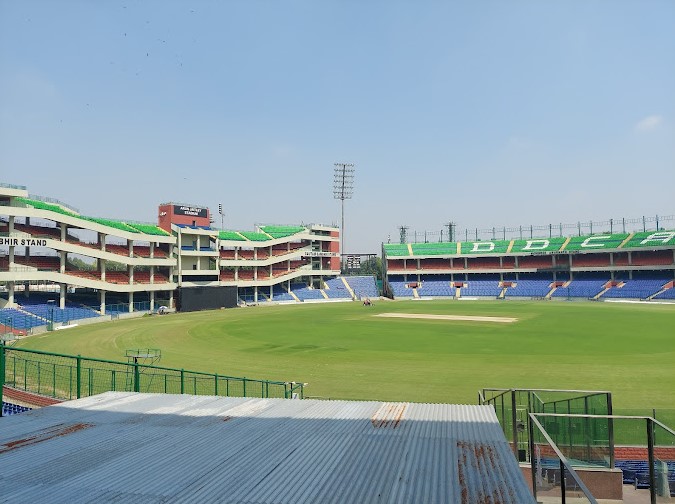Delhi Cricket Stadium: Cricket is a game of fine margins, and one such margin lies quite literally in the boundary rope that encircles the field. The length of these boundaries can greatly impact gameplay—affecting scoring rates, strategies, and the outcome of matches. The Arun Jaitley Stadium in New Delhi is one of India’s oldest and most prominent cricket venues. Known for its historic matches and enthusiastic crowd, it has also earned a reputation for being a batsman-friendly ground, due in part to its relatively short boundaries.
This article explores the boundary dimensions of the Delhi Cricket Stadium, compares it with other grounds, and discusses its impact on modern cricket.
1. Introduction to Arun Jaitley Stadium
Established in 1883, Arun Jaitley Stadium—originally the Feroz Shah Kotla Ground—is located in the heart of Delhi. The ground is operated by the Delhi & District Cricket Association (DDCA) and has been a venue for numerous international Tests, ODIs, T20Is, and IPL matches.
2. Boundary Lengths at Arun Jaitley Stadium
According to the ICC guidelines, boundary lengths should ideally range between 65 to 85 meters. Arun Jaitley Stadium generally adheres to this rule but often leans toward the shorter end, particularly square of the wicket.
Approximate Boundary Lengths at Arun Jaitley Stadium
| Direction | Distance from Center (Approx.) |
|---|---|
| Straight Boundaries | 68 – 71 meters |
| Square Boundaries | 63 – 66 meters |
| Fine Leg/Third Man | 60 – 64 meters |
| Long On/Long Off | 68 – 70 meters |
| Deep Extra Cover | 65 – 67 meters |
These distances can change slightly depending on how the boundary rope is set for a particular match, especially in T20 games where advertising boards and safety zones may pull the rope inwards by a few meters.
3. Comparison with Other Indian Grounds
To better appreciate the characteristics of the Delhi ground, it’s helpful to compare its boundaries with those of other popular stadiums across India.
Boundary Length Comparison Across Stadiums
| Stadium Name | City | Average Boundary Length (m) |
|---|---|---|
| Arun Jaitley Stadium | Delhi | 63–71 |
| Wankhede Stadium | Mumbai | 65–72 |
| Eden Gardens | Kolkata | 66–78 |
| M. A. Chidambaram Stadium | Chennai | 66–74 |
| Narendra Modi Stadium | Ahmedabad | 70–85 |
4. Effects of Short Boundaries on Gameplay
A. High-Scoring Matches
The relatively short boundaries at Delhi contribute to higher run rates, especially in limited-overs formats. Even misjudged shots often clear the rope, giving batters an edge.
B. Strategic Bowling Challenges
Bowlers, particularly spinners, need to adjust their lengths and lines carefully. Margins for error are thin, and full-length deliveries can easily be launched into the stands.
C. Field Placement Dynamics
With shorter square boundaries, captains often employ sweepers and deep cover fielders early in the innings to curb scoring.
5. Historical Matches and Boundary Statistics
Over the decades, Arun Jaitley Stadium has hosted numerous historic games. Here are a few that stand out in terms of boundary-heavy performances:
Notable High-Scoring Matches in Delhi
| Match Type | Teams | Total Score | Top Performer | 4s/6s Hit |
|---|---|---|---|---|
| ODI (2009) | India vs Sri Lanka | 414/7 | Virender Sehwag | 17 fours, 6 sixes |
| IPL (2021) | DC vs CSK | 208/6 | Rishabh Pant | 8 fours, 4 sixes |
| T20I (2022) | India vs SA | 211/4 | Ruturaj Gaikwad | 9 fours, 7 sixes |
Delhi’s ground conditions clearly favor aggressive batting, especially when the pitch is flat and boundaries are drawn slightly inward for televised matches.
6. Renovation and Its Impact on Boundaries
In recent years, the stadium has undergone phased renovation, including:
- Upgraded player dressing rooms
- Enhanced drainage systems
- Improved spectator amenities
- LED lighting for night matches
However, due to its central urban location, expanding the playing area has not been feasible. The boundary lengths have remained largely the same, reinforcing its image as a batting haven, particularly during IPL seasons.
7. Batting and Bowling Records Influenced by Boundaries
Delhi has produced some record-breaking moments, partially thanks to its boundary-friendly layout.
- Fastest ODI century by an Indian (Virender Sehwag, 60 balls vs New Zealand)
- Most IPL sixes at this venue by a single player: Rishabh Pant
For bowlers, however, Delhi can be a graveyard—unless they are tactically sharp or aided by a turning pitch.
8. Crowd Engagement and Stadium Atmosphere
With a seating capacity of around 41,800, the Arun Jaitley Stadium becomes an electrifying venue during matches. The proximity of stands to the boundary makes the crowd feel part of the action. Every six seems to land just meters away, making the experience thrilling for spectators.
9. Pitch vs Boundary: A Balanced Equation?
While the boundary lengths favor batsmen, Delhi’s pitches have traditionally helped spinners due to their dry and slow nature. This often restores some balance between bat and ball, especially in longer formats like Test matches.
The Arun Jaitley Stadium in Delhi remains a cornerstone of Indian cricket, not just for its historical legacy but also for its distinctive ground dimensions. The shorter boundaries amplify scoring potential, energize the crowd, and influence match strategies across all formats. While this may tilt the balance toward batsmen, the pitch often helps bowlers keep the contest competitive.
In modern cricket, where entertainment is as crucial as technique, Delhi’s compact dimensions make it a fan favorite and a batsman’s paradise.


